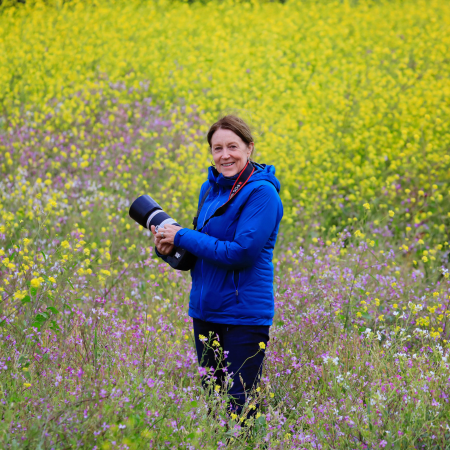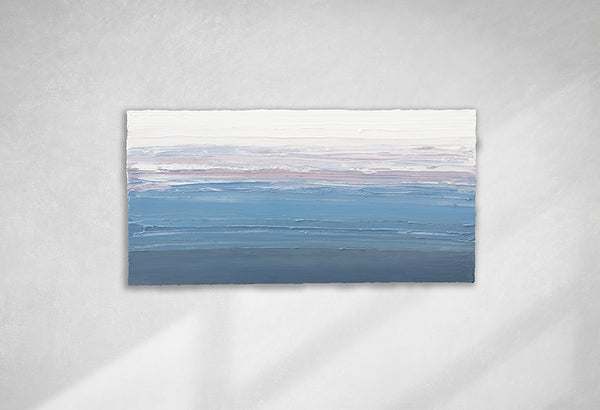A day in wild horse photographer Tori Gagne's "studio" may sometimes be in her home office, but is most often spent traveling to extremely remote locations throughout the American West, using GPS coordinates, maps, and other tools to find her wild subjects. We sat down with Tori to learn about the uniqueness of this process, how her background informs her current work, the challenges of capturing the natural world, and more. Read the discussion to learn all about Tori's process, or skip to the bottom to watch our live discussion from October 25, 2023.
Our Discussion with Tori Gagne
Where are you from originally and where are you located now?
I am from Excelsior, Minnesota and I currently live there.
How did you get started as an artist, and with your current style and medium?
I always loved art, especially photography – we had a darkroom in our home when I was a child. My mother had a masters in photo journalism, my brother has a degree in fine art, and my maternal grandmother was an oil painter, so I followed in their footsteps. My mother was an extremely creative person so I grew up trying different things using my hands as she always did. In addition to my family influences, I had great programs for photography in middle and high school. I decided to go back to school and get a BFA in Fine Art Photography once my three children were older and I had the time.

The better part of your creative process is outdoors in rural, wilderness-type settings. Can you walk us through some of this process?
To prepare for a wild horse shoot I first decide which herd management area I would like to go to and see if I can find really good GPS coordinates for navigating the dirt roads from other photographers and wild horse advocates. There are 177 herd management areas in ten different states in the U.S. - I have been to maybe fifteen of them. All herd management areas have some kind of roads - sometimes they are maintained dirt roads, but more often than not they are 2-track dirt roads, literally in the middle of nowhere. The Bureau of Land Management (BLM) has maps available, but generally they are not to scale and don’t show all of the small 2-track roads where you can find the horses. Usually, other photographers are happy to share information on how to get to the horses, and I like to know where the water holes are as well as that is a good place to find horses in the morning or evening.
I generally drive west from Minneapolis and have flown only on occasion - mostly, it's a road trip excursion. My husband has a high-clearance truck which is absolutely necessary for most of the places I go. Luckily, he loves to drive off-road and is really good at navigating tricky spots with mud, rocks and exposure. You have to be aware of landmarks, and cell phone GPS is very helpful. Getting up way before sunrise and staying until sunset are part of the process. And sometimes I camp out there, depending on whether there is a town nearby with a hotel. There is a lot of waiting and watching. Sometimes I'll see all of the signs - fresh manure, stud piles and tracks, but never find the horses. It's all just part of the process.

How do you decide on a location? Is there anywhere you haven’t visited to photograph yet that you really want to go?
I usually go to places where I know I will have success and know the area from prior visits. But for instance, recently we were visiting friends in Colorado two weekends back-to-back, so between them I looked for places we could go that had wild horses, and ended up visiting two herd areas I had not been to before.
As far as where I'd like to go next, I would like to photograph the wild burros in Arizona this winter, as we are going there for a family trip and I will tack on a few days for that. I also want to visit the wild horses in Portugal, where they have a re-wilding project I want to learn more about. And, I'd like to photograph the beautiful domestic horses in Portugal and Spain.
What is the most rewarding part of your process?
The most rewarding thing is just observing the behavior of the horses, their family dynamics, being out on the land, feeling the energy of the locale and the horses. Observing other wildlife is always very satisfying as well. I can’t describe to you in words how amazing the public lands that the horses live on are – how deeply it fills my soul to be out where there is nothing but me and nature. It's an experience filled with awe and wonder. You feel how small you are in the vast landscape; it is a good thing to be reminded to have reverence for how amazing and powerful nature is. It is something most people do not experience often as our lives have become so urban and disconnected from the land and the elements.

What’s the most challenging part?
The weather and the light can sometimes make the whole shoot not turn out but I am still grateful for the opportunity to try, and whatever experience I had, even if the images were not what I had envisioned. Anytime I get to be out in the sage-covered landscapes of the west is great!
Spending time among and around wild animals could be a little tricky. Do you find that you have to gain the trust of these animals when photographing them? How to you gauge how close you can safely get to them?
It often depends on the particular herd - if they were recently in a helicopter round up where they were traumatized, for example, or how frequently they see humans. I always use a very long lens and stay as far away as I need to so as not cause them to change their behavior. There are usually Lieutenant stallions for a band (family) who stay on the periphery of the herd. They will generally watch my behavior and make sure I keep my distance. You need to have a deep respect for the horses, especially the stallions as they can be very unpredictable if they are sparring with another male.
You have varying series of photography – all that capture nature, but some are of animals, some of trees, some of more abstracted coastlines. Is there a common thread that draws you to each of these aspects of the natural world? Or are you drawn to photograph them for individual or more isolated reasons?
The images I create of abstracted coastlines are from my travels - some were made when I visited the wild horses on the Shackleford Banks in North Carolina. I also like to make these types of images of Lake Superior where there is a lot of dramatic, swiftly-changing weather. Minnesotans like to get out of the cold weather in the winter and going to the ocean is very healing when you have such long cold winters! I use that as an opportunity for photography.
As for the tree series I like to play with motion blur in my camera settings to capture only the darks or the lights, and then layer those images in camera and also digitally in post processing. I practice this type of photography when I am not shooting in the wild. I have a fondness for abstraction – I guess it is antithetical to the more literal mages of the horses that I make. I have a long background in garden design where I ran a small business as my first career so my affinity for plants and trees more specifically stems from that. I also love to try new things – I use my photographs to create encaustic art work in a small basement studio in the winter. This involves melted beeswax, embedding my images printed on tissue paper, then embedding in molten wax and then creating a new piece of mixed media art adding pastels and oil pigments with the wax. I do not have a series of this work that I am ready to show yet – but I look forward to continuing working with this medium as well as my photography.

Have you ever considered photographing different wild animals, other than horses? Why or why not?
I do have a few nice images of bighorn sheep and pronghorn that I have taken while photographing wild horses. There are mule deer, sage grouse, antelope, elk and coyote that I regularly see I just haven’t spent a lot of focused time working on other species although I never rule something out, maybe other species will become more interesting to me as time goes on.
How often do you set out for a photo shoot, say, in a year?
For shooting wild horses I set out four or five times a year.
Are there any particular artists who have inspired you or to whom you feel connected in some way?
I feel a kinship with other wild horse photographers as I fully understand and appreciate what they do and why they are so drawn to these magnificent beings. There are many photographers that inspire me, I read about photography on a regular basis and look at the work of others of all genres. I also am inspired by other artists working in other mediums as well. But there really is not one in particular that stands out.
From your first shoot to now, has your work overall changed? If so, in what way(s)?
I have a keener eye and a confidence that I may not have had 14 years ago. I intuitively know what I am looking for in an image and how to capture it, although with animals, landscapes, light and weather there are a lot of variables that factor in to the process. I try to have a beginner’s mind and I am keen on learning new things as I go. I look back on older work and have much to be proud of, I always see things anew when looking back due to my growth as an artist.

If you could give one piece of advice to your younger self as an artist, what would it be?
To know that this work is a process and there is much to learn from others, being persistent and focused will pay off.
What is your goal as an artist? Is there any particular message you want to send to viewers or collectors (whether it be all your work or an individual series)?
My goal is to keep learning, staying vital by creating work and putting it out into the world. For viewers and collectors to know how much I truly appreciate their support of my passion. I am grateful every day for the fact that I get to connect with these magnificent beings.

Now for something different: Are you a morning person or night person?
Morning.
Cats or dogs?
Both!
Coffee or tea?
Coffee.
Mountains or ocean?
Mountains.
In the spirit of Halloween, Snickers or Almond Joy?
Snickers but, could be a toss-up!
Pumpkin carving or apple picking?
Pumpkin carving.
If you could be any animal, what would you be?
Perhaps a cat - they are independent and have their own way of doing things!
What’s your favorite place on earth?
Home and Ketchum, Idaho.
To explore Tori's full collection of fine art photography, visit her Artist Collection. You can also click below to watch our live Q&A with Tori from Wednesday, October 25, 2023.




0 comments
Post a comment